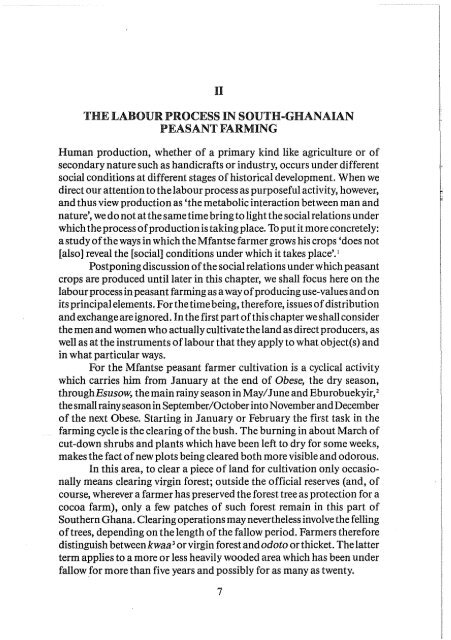Create successful ePaper yourself
Turn your PDF publications into a flip-book with our unique Google optimized e-Paper software.
II<br />
THE LABOUR PROCESS IN SOUTH-GHANAIAN<br />
PEASANT FARMING<br />
Human production, whether of a primary kind like agriculture or of<br />
secondary nature such as handicrafts or industry, occurs under different<br />
social conditions at different stages of historical development. When we<br />
direct our attention to the labour process as purposeful activity, however,<br />
and thus view production as 'the metabolic interaction between man and<br />
nature', we do not at the same time bring to light the social relations under<br />
which the process of production is taking place. To put it more concretely:<br />
a study of the ways in which the Mfantse farmer grows his crops 'does not<br />
[also] reveal the [social] conditions under which it takes place'. I<br />
Postponing discussion ofthe social relations under which peasant<br />
crops are produced until later in this chapter, we shall focus here on the<br />
labour process in peasant farming as a way of producing use-values and on<br />
its principal elements. For the time being, therefore, issues of distribution<br />
and exchange are ignored. In the first part of this chapter we shall consider<br />
the men and women who actually cultivate the land as direct producers, as<br />
well as at the instruments of labour that they apply to what object(s) and<br />
in what particular ways.<br />
For the Mfantse peasant farmer cultivation is a cyclical activity<br />
which carries him from January at the end of Obese, the dry season,<br />
throughEsusow, the main rainy season in MayIJune and Eburobuekyir, 2<br />
the small rainy season in September/October into November and December<br />
of the next Obese. Starting in January or February the first task in the<br />
farming cycle is the clearing of the bush. The burning in about March of<br />
cut-down shrubs and plants which have been left to dry for some weeks,<br />
makes the fact of new plots being cleared both more visible and odorous.<br />
In this area, to clear a piece of land for cultivation only occasionally<br />
means clearing virgin forest; outside the official reserves (and, of<br />
course, wherever a farmer has preserved the forest tree as protection for a<br />
cocoa farm), only a few patches of such forest remain in this part of<br />
Southern Ghana. Clearing operations may nevertheless involve the felling<br />
of trees, depending on the length ofthe fallow period. Farmers therefore<br />
distinguish between kwaa 3 or virgin forest and odoto or thicket. The latter<br />
term applies to a more or less heavily wooded area which has been under<br />
fallow for more than five years and possibly for as many as twenty.<br />
7
















